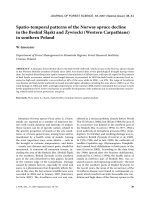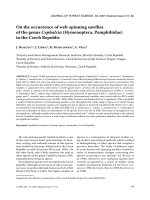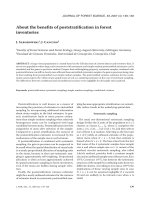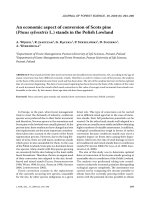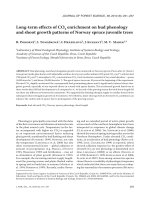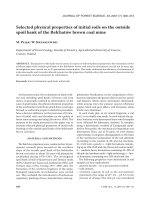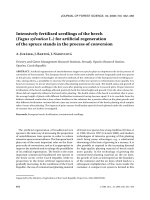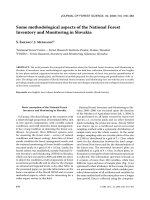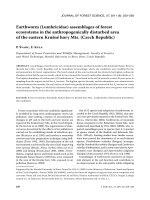Báo cáo lâm nghiệp: "On the occurrence of web-spinning sawflies of the genus Cephalcia (Hymenoptera, Pamphiliidae) in the Czech Republic" potx
Bạn đang xem bản rút gọn của tài liệu. Xem và tải ngay bản đầy đủ của tài liệu tại đây (271.35 KB, 6 trang )
J. FOR. SCI., 53, 2007 (Special Issue): 57–62 57
JOURNAL OF FOREST SCIENCE, 53, 2007 (Special Issue): 57–62
On the occurrence of web-spinning sawflies
of the genus Cephalcia (Hymenoptera, Pamphiliidae)
in the Czech Republic
J. H
1,2
, J. L
1
, R. M
1
, A. V
3
1
Forestry and Game Management Research Institute, Jíloviště-Strnady, Czech Republic
2
Faculty of Forestry and Wood Sciences, Czech University of Life Sciences Prague, Prague,
Czech Republic
3
Faculty of Science, Palacký University, Olomouc, Czech Republic
ABSTRACT: In total, 55,862 specimens of seven species of the genus Cephalcia (C. abietis, C. arvensis, C. alashanica,
C. alpina, C. annulicornis, C. erythrogaster, C. masuttii) were collected using Malaise traps in spruce mountain forests
from 2001 to 2006. Sex ratio was male biased as a result of used methods; males are more active and quicker. e
flight activity started in the studied localities at the beginning of May or the beginning of June depending on the actual
weather. C. alpina flew first, followed by C. erythrogaster and C. arvensis, the last flying species were C. alashanica
and C. abietis. C. abietis was the most abundant in all localities within all years (total dominance of 93%). C. arvensis,
C. alashanica
and C. alpina were collected in more than hundred of specimens while C. annulicornis, C. erythro-
gaster and C. masuttii were collected only occasionally. Environmental variables were tested with the RDA model
which proved several of them (years of 2001–2003, 2006, Český les and Slavkovský les) as significant. is is probably
a result of following facts: (i) web-spinning sawflies occur throughout the whole range of spruce in Central Europe
(therefore only two mountain regions were significant, but no species is positively correlated with them); (ii) C. abie-
tis expanded in the Krkonoše Mts. in 2003 and 2006; (iii) C. alashanica, C. alpina, C. annulicornis, C. erythrogaster
were more abundant in 2002; (iv) abundances of all species were very low in 2000. e factor of management was
not significant, although samples from cultural forests prevailed and C. abietis was the most abundant in the cultural
forests. Cephalcia species occur in a wide range of altitudes without any clear preference therefore this variable was
not significant neither.
Keywords: Cephalcia; faunistics; Norway spruce; mountains; Czech Republic
Supported by the Ministry of Agriculture of the Czech Republic, Project No. MZe 0002070201.
e web-spinning sawfly Cephalcia abietis is one
of the most serious forest pests therefore its bion-
omy, ecology and outbreak reasons of this species
were studied in Germany, Poland and in the Czech
Republic as well (P-W 1982). On
the other hand, only a little attention was paid to
other species of the genus Cephalcia Panzer, 1805,
especially those living on spruce.
Ten Cephalcia species were recorded in the Czech
Republic, although occurrences of only seven spe-
cies were recently confirmed (G, B 1940;
B 1976; Š 1989). The higher number of
species is a consequence of intensive studies us-
ing modern taxonomical methods which resulted
in distinguishing of other species that escaped a
previous detection. The study of different types
of so far known web-spinning sawflies resulted in
series of nomenclature changes concerning also
species occurring in our territory (cf. B et
al. 1998). Moreover, new Cephalcia species were
recently recognized as a result of studies using
modern taxonomical methods (cf. B, Z-
1994; B, B 1998; B et
al. 1998).
58 J. FOR. SCI., 53, 2007 (Special Issue): 57–62
Because of the lack of a recent survey of Cephal-
cia species in the Czech Republic, the goals of this
study were (i) to monitor web-spinning sawflies liv-
ing on spruce in mountainous regions and (ii) to
compare species composition and abundances of
these species in cultural and near-natural spruce
forests.
MATERIAL AND METHODS
e web-spinning sawflies were studied by Mal-
aise traps of Townes type (T 1972). Traps
were placed in closed older spruce (Picea abies
[L.] Karst.) forests, 80–110-years-old, at the dis-
tance of 50 m from the forest edge. e habitat
belongs to the association Athyrio alpestris-Picee-
tum, Calmagrostio villosae-Piceetum and localities
lay in mountainous regions of the Czech Republic;
(i) Euhercynicum (the Šumava Mts., Slavkovský les,
Český les, Brdy Upland and Žďárské vrchy Upland),
(ii) Sudeten (the Krkonoše Mts. and the Krušné hory
Mts.) and (iii) Carpathians (the Moravskoslezské
Beskydy Mts.). Only one trap was placed on each
locality because there was no difference in num-
bers of sampled sawflies among five traps placed in
line (H et al. 2007). In three areas (localities
Trojmezná Mt., Medvědín Mt. and Klínovec Mt.),
pairs of “near-natural forest” and “cultural forest”
(according to V, H 2004) were found and
traps were operated in both forest types in parallel
(Table 1).
e traps were installed from the end of April to
the end of October and emptied in two-week or
one month intervals during the period 2001–2006.
e sawflies were determined according to the key
of V (2002) and the voucher specimens
are preserved in Forestry and Game Management
Research Institute Jíloviště-Strnady.
Data were processed by multivariate analysis (re-
dundancy analysis) using software pack CANOCO
for Windows 4.5
©
(T B, Š 1998).
Furthermore, the Monte-Carlo permutation test
(499 permutations) was used for a significance as-
sessment of environmental variables.
RESULTS AND DISCUSSION
Faunistics
In total, 55,862 specimens of seven species of the
genus Cephalcia (C. abietis – 52,127 ex, C. arven-
sis – 2,933 ex, C. alashanica – 476 ex, C. alpina
+ C. annulicornis – 227 + 21 ex; C. erythrogaster
– 77 ex;
C. masuttii – 1 ex) were collected from
2001 to 2006 (Table 1). Sex ratios were male biased
(95% of males) as a result of used methods since
males are more active flyers. In Cephalcia species,
ratios of emerged males and females are known to
be equal (P-W 1982).
C. abietis was the most abundant species fol-
lowed by C. arvensis, C. alashanica and C. alpina
(Table 1). All these species are common and abun-
dant in Central Europe (cf. B 1976; P-
W 1982). C. abietis is a very serious pest
in forestry. Several serious outbreaks are known in
Central Europe from the end of 19
th
century and
the beginning of the 20
th
century (E 1942;
P-W 1982). In the Czech Republic,
many severe outbreaks occurred with the heaviest
one in the 1980s (cf. L et al. 1991). Local out-
breaks of C. arvensis and C. alpina were reported by
several authors (cf. K, Š 1986; M-
1988, 1991; L 1998, 1999). C. alashani-
ca was a common species in the Moravskoslezské
Beskydy Mts.; elsewhere it was rare. Two speci-
mens caught in the Šumava Mts. represent the first
record from this area.
e record of C. masuttii is the most interesting
from the faunistic point of view. It is the first re-
cord in the Czech Republic (already published in
J et al. 2005) and its description, as web-
spinning sawfly, was also based on materials from
the Bavarian Forest Mts. (B, B 1998).
Our locality is placed 10 km apart from the local-
ity of Bodenmais in Bavaria, listed in the species
description study 3 prepupae (B, B
1998). Only a single above mentioned specimen
was found in the Czech Republic even by using
the very effective methods of collecting sawflies
with Malaise traps and a collar tree trap (see also
J et al. 2005).
Apart from C. annulicornis and C. masuttii, C. ery-
throgaster was the rarest species but it occurred
in all studied mountains nevertheless. All spruce
Cephalcia species probably occur in the whole
range of spruce in Central Europe, but some of
them in very low densities.
Notes to taxonomical problems
Recently, C. annulicornis was repeatedly vali-
dated as a separate species distinguished from
C. alpina
(cf. B et al. 1998; as C. falleni and
C. annulicornis
). Using identification features given
by B et al. (1998), C. annulicornis could be
recognized in 10% of the C. alpina material, but the
determination using diagnostic external characters
is very problematic. ere is a continuous transi-
J. FOR. SCI., 53, 2007 (Special Issue): 57–62 59
Table 1. Survey of studied web-spinning sawflies of the genus Cephalcia in the Czech Republic
Mountains Šumava Mts. Krkonoše Mts. Brdy Upland
Krušné
hory
Mts.
Český
les
Slavkovský
les
Žďárské
vrchy
Upland
Beskydy Mts.
Total
Dominance (%)
Species/ locality
Trojmezná Mt.
(commercial forest)
Jezerní hora Mt.
(near-natural forest)
Medvědín Mt.
(near-natural forest)
Medvědín Mt.
(commercial forest)
Velký Tok
Hill Praha
Klínovec Mt.
(near-natural forest)
Klínovec Mt.
(commercial forest)
Dyleň (Horní)
Dyleň (Dolní)
Kladská (Kynžvart)
Kladská (Kynžvart)
Kladská (Ztracená)
Šindelní vrch Mt.
Smrk Mt. (Podolánky)
Smrk Mt. (Daličany)
Smrk Mt. (Daličany)
Radhošť Mt.
Blato Mt. (Bařiny)
Year
2003
2004
2006
2003
2005
2006
2003
2004
2006
2003
2004
2006
2005
2006
2001
2004
2004
2002
2002
2001
2002
2002
2006
2001
2002
2001
2002
2001
2002
2001
2001
Longitude; latitude
48°46'N, 13°49'E
49°10'N, 13°11'E
50°44'N, 15°35'E
50°45'N, 15°35'E
49°42'N, 13°52'E
49°41'N, 13°51'E
50°23'39''N, 12°58'30''E
50°23'32''N, 12°58'42''E
12°31'E, 49°58'N
12°31'E, 49°57'N
12°39'E, 50°06'N
12° 40'E, 50°06'N
49°39'N, 15°56'E
18°22'E, 49°29'N
18°21'E, 49°29'N
18°22'E, 49°29'N
18°14'E; 49°28'N
18°19'E, 49°28'N
Altitude (m a.s.l.) 1,230 1,180 1,150 1,100 840 820 1,150 820 790 800 820 770 820 940 920 850 830
C. abietis
(Linnaeus, 1758)
1 0 27 107 12 82 17 0 146 969 9 3,126 0 275 8 1 3 5,541 3,574 10 1,749 474 10,058 24 6,440 50 4,399 6 15,016 2 2 52,127 93.311
C. annulicornis
(Hartig, 1837)
0 0 0 1 1 0 0 0 0 0 0 0 0 0 0 0 0 0 0 0 0 0 0 0 5 0 14 0 0 0 0 21 0.015
C. alashanica
Gussakovskij, 1935
0 0 1 0 0 1 0 0 0 0 0 0 0 0 0 0 0 12 0 0 8 1 6 0 195 0 51 0 201 0 0 476 0.852
C. alpina (Klug,
1808)
13 89 0 11 4 7 2 0 1 2 1 3 6 15 0 2 1 1 2 0 1 1 7 0 21 0 22 0 28 0 0 227 0.406
C. arvensis Panzer,
1805
31 49 36 111 35 46 19 2 291 42 6 286 28 354 5 26 52 42 20 0 1 13 152 11 239 57 220 13 775 1 1 2,933 5.250
C. erythrogaster
(Hartig, 1837)
0 2 0 2 3 6 1 0 0 0 2 0 1 19 0 0 0 0 1 0 1 1 4 0 12 0 12 0 10 0 0 77 0.138
C. masuttii Battisti
& Boato, 1998
0 0 0 1 0 0 0 0 0 0 0 0 0 0 0 0 0 0 0 0 0 0 0 0 0 0 0 0 0 0 0 1 0.002
C. sp. 0 0 0 0 0 0 0 0 0 0 0 0 2 0 0 0 0 0 0 0 0 0 0 0 0 0 0 0 0 0 0 2 0.015
Total 45 140 64 233 55 142 39 2 438 1,013 18 3,415 37 663 13 29 56 5,596 3,597 10 1,760 490 10,227 35 6,912 107 4,718 19 16,030 3 3 55,864 100
60 J. FOR. SCI., 53, 2007 (Special Issue): 57–62
tion in diagnostic features between both species in
our material.
C. arvensis is morphologically as well as bionomi-
cally a very variable species. e pale specimens
significantly varied in size in the collected material.
ere were also found big dark specimens mainly
with dark dorsal side of abdomen. Similar specimens
were described as f. irrorata Dahl., which is very
similar to C. intermedia Helén known from North-
ern Europe. It is supposed that this species does not
occur in Central Europe, but two of our specimens
resemble this species (listed as C. sp. in Table 1).
Phenology
is study confirmed previously known periods
of the Cephalcia species flight activities (cf. M-
1988). e flight activity started in the stud-
ied localities at the end of May or at the beginning
of June depending on the actual weather. C. alpina
flew first, followed by C. erythrogaster and C. arven-
sis, the last flying species were C. alashanica and
C. bietis
. All species flew until the beginning or the
end of July with exception of C. arvensis which was
sampled even in August.
Not recorded species of Cephalcia
ree species of the genus Cephalcia known
from the territory of the Czech Republic were not
found (C. fulva, C. hartigi and C. lariciphila). e
host plant of C. fulva is also spruce (cf. V
2002), but this species is known only from eastern
part of the country (cf. B, Z 1994).
C. hartigi is associated with Abies (cf. V
2002) and it was reported by B (1976) from
several localities only. C. lariciphila feeds on La-
rix (cf. V 2002) and it is common in the
Czech Republic (B 1976). A recent outbreak
of C. lariciphila was reported from Větrný Jeníkov
(V, H 2006). is species was
not found in surroundings of the studied localities
since larch lacks.
Model
e importance of all explanatory variables, their
significance and correlations with axes are presented
in Fig. 1 and Table 3. e first canonical axis explains
38.8% of variability, both canonical axes explain 53%
of variability (Table 2). All axes explain 100% of vari-
ability. e whole model was statistically significant
(F = 2.2, P < 0.05) though only several environmental
variables (years of 2001–2003, 2006, Český les and
Slavkovský les) were significant (Table 3).
is is probably a result of several facts: (i) web-
spinning sawflies occur throughout the whole
range of spruce (therefore only two mountain re-
gions were significant, but no species is positively
correlated with them); (ii) C. abietis expanded in
the Krkonoše Mts. in 2003 and 2006 (L 2006)
what explains the positive correlation with C. abie-
Table 2. Summary of variability explained by the main axes in the RDA model
Axes
1 2 2 4
Eigenvalues 0.39 0.14 0.08 0.04
Species-environment correlations 0.91 0.69 0.8 0.8
Cumulative percentage variance of species data 38.8 52.4 60.3 64.5
Cumulative percentage variance of species-environment relation 59 79.6 91.5 97.9
Fig. 1. Ordination diagram (RDA) showing an influence of
years, localities, altitudes and forest management on Ce-
phalcia species occurrence. Canonical axes explain 65.8%
of variability
J. FOR. SCI., 53, 2007 (Special Issue): 57–62 61
tis; (iii) C. alashanica, C. alpina, C. annulicornis,
C. erythrogaster were more abundant in 2002 (Ta-
ble 1); (iv) abundances of all species were very low
in 2000 (Table 1).
Although samples from cultural forests prevailed
and C. abietis was the most abundant species in the
cultural forests at first appearance (Table 1), the
variable of management was not significant. e
collected material is probably insufficient to decide
this aspect definitely. Cephalcia species occur in a
wide range of altitudes without any clear prefer-
ence therefore the altitude was not significant in
our analysis neither.
Re ference s
BATTISTI A., BOATO A., 1998. Cephalcia masuttii sp. n.
(Hymenoptera, Pamphiliidae), a new web-spinning sawfly
living on spruce. European Journal of Entomology, 95:
251–262.
BATTISTI A., ZANOCCO D., 1994. Biosystematics of Ce-
phalcia arvensis Panzer group. I. Description of Cephalcia
fulva n. sp. (Hymenoptera, Pamphiliidae). Redia, Firenze,
77: 297–311.
BATTISTI A., BOATO A., ZANOCCO D., 1998. Two sibling
species of the spruce web-spinning sawfly Cephalcia fal-
lenii (Hymenoptera: Pamphiliidae) in Europe. Systematic
Entomology, 23: 99–108.
Table 3. Results of the redundancy analysis of explanatory variables, their significance and correlations with the axes
Explanatory variable AX1 AX2 AX3 AX4 P F I. F.
2002 –0.4737 –0.2585 –0.4476 –0.0278 0.004 5.14 11.5050
2006 –0.2433 0.4357 0.1247 0.1315 0.008 4.41 0
Slavkovský les 0.2446 –0.0520 –0.4420 –0.3962 0.010 4.34 1.3435
Český les 0.0132 –0.1227 –0.0417 0.2208 0.012 4.27 1.4660
2003 –0.0063 0.3115 0.1018 –0.2295 0.028 3.39 2.3663
2001 0.535 –0.0819 –0.2736 0.0148 0.076 2.15 9.3966
Krkonoše Mts. 0.1417 0.2498 0.0327 0.1368 0.182 1.65 11.8677
Beskydy Mts. –0.1868 –0.2079 –0.3323 0.1258 0.258 1.36 0
Krušné hory Mts. 0.0972 –0.1014 0.2218 0.3344 0.402 0.91 6.0395
Altitude –0.0992 –0.0073 –0.4905 0.1513 0.574 0.66 3.8616
2004 0.1875 –0.2911 0.3956 0.0943 0.640 0.59 3.3560
Žďárské vrchy Upland –0.1806 –0.0055 0.0345 0.0608 0.618 0.56 2.8519
2005 0.0149 –0.1107 0.2957 –0.0173 0.728 0.49 1.7149
Šumava Mts. –0.1020 0.1011 0.3764 –0.2544 0.700 0.48 11.0601
Cultural forest –0.0456 –0.1987 –0.1588 0.0657 0.810 0.35 1.6895
Brdy Upland –0.0049 0.0803 0.2167 –0.1305 0.970 0.07 3.2033
BENEŠ K., 1976. Revision of the European species of Ce-
phalcia Panzer, 1805 (Hymenoptera, Pamphiliidae). Studie
ČSAV 3. Praha, Academia: 67.
BLANK S. M., SHINOHARA A., TAEGER A., 1998. Revision-
ary notes on pamphiliid sawflies (Hymenoptera, Symphyta:
Pamphiliidae). Deutsche Entomologische Zeitschrift, 45:
17–31.
ESCHERICH K., 1942. Die Forstinsekten Mitteleuropas. Bd. 5.
Berlin, Paul Parey.
GREGOR F., BAŤA L., 1940. Symphyta (Chalastogastra,
Tenthredinoidea). In: BAŤA L. (ed.), Prodromus našeho
blanokřídlého hmyzu. Prodromus Hymenopterorum pat-
riae nostrae. Pars IV. Sborník Entomologického oddělení
Národního Musea Praha, 18: 203–249.
HOLUŠA J., LIŠKA J., DRÁPELA K., 2007. Srovnání odchytu
dospělců ploskohřbetek rodu Cephalcia sp. (Hymenoptera:
Pamphiliidae) s půdními denzitami larev v období latence.
Zprávy lesnického výzkumu, 52: 258–263.
JACHYM M., LIŠKA J., HOLUŠA J., 2005. First record
of Cephalcia masuttii (Hymenoptera: Pamphiliidae) in
Poland and the Czech Republic. Entomological Problems,
35: 113–114.
KŘÍSTEK J., ŠVESTKA M., 1986. Gradace ploskohřbetky
severské (Cephalcia arvensis Pz.) na severní Moravě. In:
Sborník referátov z konferencie Uplatňovanie výsledkov
výskumu v ochrane lesov, Zvolen, 11.–12. Jún 1986. MLVH
SSR, Stredoslovenské štátne lesy, PR Banská Bystrica,
Pobočka ČSVTS VÚLH Zvolen: 103–108.
62 J. FOR. SCI., 53, 2007 (Special Issue): 57–62
LIŠKA J., 1998. Outbreaks of Cephalcia spp. (Hymenoptera,
Pamphiliidae) in spruce stands on the territory of the
Czech Republic. In: BRUNNHOFER V., SOLDÁN T. (eds),
Book of Abstracts. VI
th
European Congress of Entomology,
České Budějovice, August 23–29, 1998. České Budějovice,
Institute of Entomology, Academy of Sciences of the Czech
Republic, University of South Bohemia: 507.
LIŠKA J., 1999. Ploskohřbetky rodu Cephalcia (Hymenoptera,
Pamphiliidae) žijící na smrku. Zpravodaj ochrany lesa, 5:
21–23.
LIŠKA J., 2006. K výskytu ploskohřbetky smrkové. Lesnická
práce, 85: 481.
LIŠKA J., PÍCHOVÁ V., KNÍŽEK M., HOCHMUT R., 1991.
Přehled výskytu lesních hmyzích škůdců v českých zemích.
Lesnický průvodce 3. Jíloviště-Strnady, VÚLHM: 37 + 30.
MARTINEK V., 1988. Zastoupení a fenologie líhnutí dospělců
jednotlivých druhů ploskohřbetek rodu Cephalcia Pz.
(Hym., Pamphiliidae) v synuzii – polohy nad 700 m n. m.
Lesnictví, 34: 385–410.
MARTINEK V., 1991. Přemnožení ploskohřbetky severské
(Cephalcia arvensis Panz.) (Hym., Pamphiliidae) ve východ-
ních Čechách. Lesnictví, 37: 543–570.
MARTINEK V., 1992. Nový škůdce smrku, ploskohřbetka
černá (Cephalcia falleni (Dalm.)) (Hym., Pamphiliidae),
v Orlických horách. Lesnictví-Forestry,
38: 205–220.
PSCHORN-WALCHER H., 1982. Pamphiliidae, Gespinst-
blattwespen. In: SCHWENKE W. (ed.), Die Forstschädlinge
Europas, Bd. 4. Hautflügler und Zweiflügler. Hamburg,
Berlin, Paul Parey: 23–57.
ŠEDIVÝ J. (ed.), 1989. Enumeratio Insectorum Bohemoslova-
kiae. Checklist of Czechoslovak Insects, 3 (Hymenoptera).
Acta Faunistica Entomologica Musei Nationalis Pragae,
19: 1–194.
TER BRAAK C.J.F., ŠMILAUER P., 1998. CANOCO Reference
Manual and User’s Guide to Canoco for Windows: Software
for Canonical Community Ordination (Version 4). Ithaca,
Microcomputer Power.
TOWNES H., 1972. A light-weight Malaise trap. Entomologi-
cal News, 83: 239–247.
VEJPUSTKOVÁ M., HOLUŠA J., 2006. Impact of defolia-
tion caused by the sawfly Cephalcia lariciphila (Hyme-
noptera: Pamphiliidae) on radial growth of larch (Larix
decidua Mill.). European Journal of Forest Research, 125:
391–396.
VRŠKA T., HORT L., 2004. Příspěvek k ustálení terminologie
zejména pro lesy v chráněných územích. Ochrana přírody,
59: 35–37.
VIITASAARI M. (ed.), 2002. Sawflies (Hymenoptera, Sym-
phyta) I. Helsinki, Tremex Press.
K výskytu ploskohřbetek rodu Cephalcia (Hymenoptera, Pamphiliidae)
v České republice
ABSTRAKT: V letech 2001–2006 bylo pomocí Malaiseho lapačů odchyceno v horských smrčinách České republiky
celkem 55 862 jedinců rodu Cephalcia (C. abietis, C. arvensis, C. alashanica, C. alpina, C. annulicornis, C. erythro-
gaster, C. masuttii). V materiálu výrazně převažovali samci, což je způsobeno tím, že samci jsou aktivnější a rych-
lejší letci. Letová aktivita začínala na studovaných lokalitách na konci května nebo na počátku června v závislosti
na počasí. C. alpina létala první, následována C. erythrogaster a C. arvensis, poslední poletovala C. alashanica a C.
abietis. C. abietis byla nejpočetnější ve všech letech a na všech lokalitách (93 %). Celkem bylo odchyceno několik
stovek jedinců C. arvensis, C. alashanica a C. alpina, zatímco druhy C. annulicornis, C. erythrogaster a C. masuttii
byly sbírány jen výjimečně. V modelu RDA byly statisticky signifikantní jen některé environmentální proměnné (roky
2001–2003, 2006, pohoří Český les a Slavkovský les). To je pravděpodobně důsledkem několika faktorů: (i) pilatky se
vyskytují v celém areálu smrku, proto byly statisticky signifikantní pouze dva regiony; (ii) C. abietis gradovala v roce
2003 a 2006 v Krkonoších; (iii) C. alashanica, C. alpina, C. annulicornis a C. erythrogaster byly početnější v roce
2002; (iv) početnost všech druhů byla v roce 2000 nízká. Faktor managementu nebyl signifikantní, i když početnost
kusů ve vzorcích z hospodářských lesů převládala a C. abietis v nich byla početnější. Ploskohřbetky se vyskytují ve
vyšších polohách bez zjevné závislosti na nadmořské výšce.
Klíčová slova: Cephalcia; faunistika; smrk; hory; Česká republika
Corresponding author:
Ing. J H, Ph.D., Výzkumný ústav lesního hospodářství a myslivosti, v.v.i., Jíloviště-Strnady,
pracoviště Frýdek-Místek, Nádražní 2811, 738 01 Frýdek-Místek, Česká republika
tel./fax: + 420 558 628 647, e-mail:

